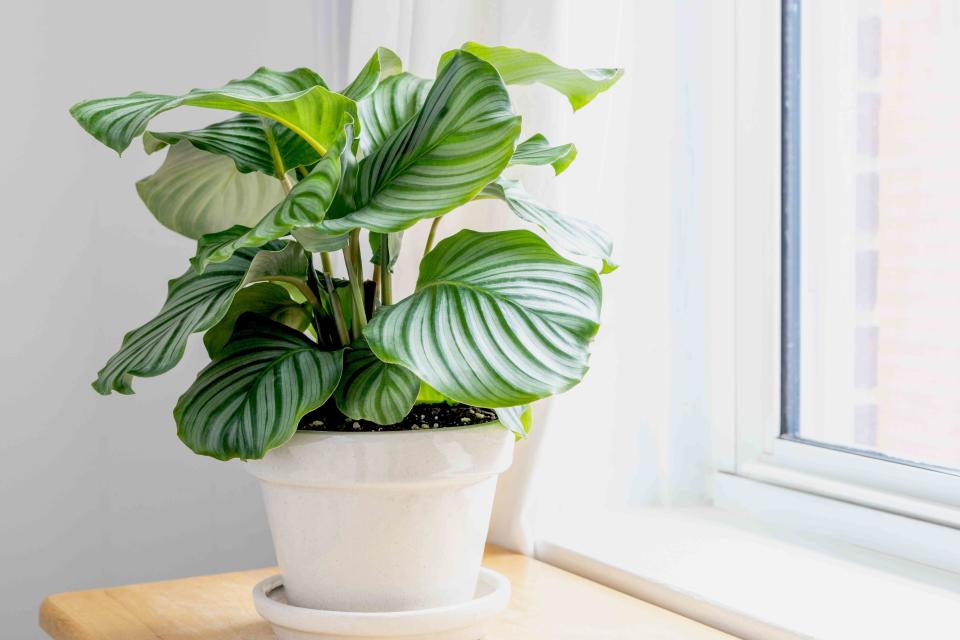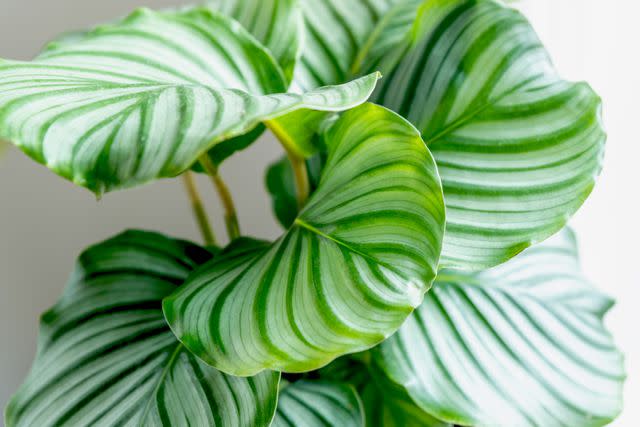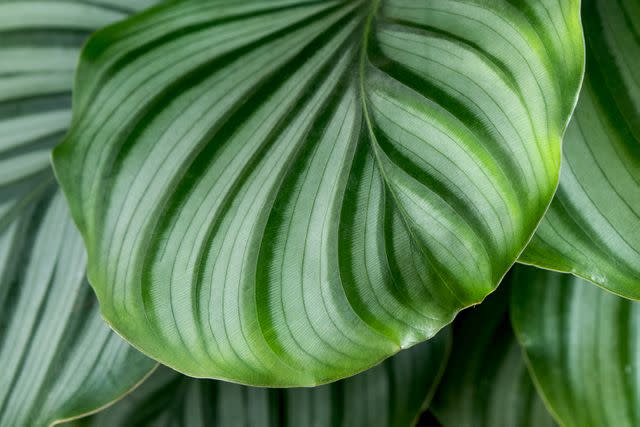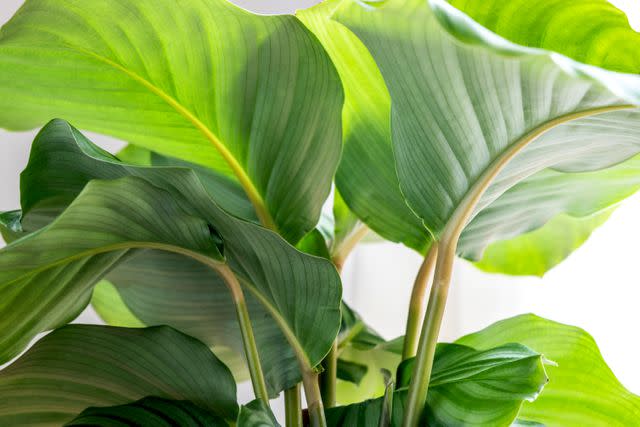How to Grow and Care for Calathea Orbifolia
This particular plant is tricky for beginners, but worth the effort.

The Spruce / Adrienne Legault
Reviewed by Kathleen Miller
It's not hard to see why so many houseplant enthusiasts covet calathea species. These striking tropical beauties have distinct stripes and veining on their oblong foliage. However, they're not always the best choice for novice plant lovers as they're particular when it comes to the care and conditions they require (think frequent watering and high humidity).
The round-leaved calathea (Calathea orbifolia or, the more recent synonym, Geoppertia orbifolia) is no exception. The silver-green stripes on its luxuriant, large leaves make it a bold statement plant, but it's somewhat fussy and definitely doesn't fall into the low-maintenance category.
However, this tricky plant has lots going for it if you're willing to put in the extra effort. Calthea oribifolia is fast-growing, pet-friendly, lush, and eye-catching.
Common Name | Round-leaved calathea |
Botanical Name | Calathea orbifolia syn. Geoppertia orbifolia |
Family | Marantaceae |
Plant Type | Perennial, herbaceous |
Mature Size | 2-3 ft. tall, 1-2 ft. wide |
Sun Exposure | Partial |
Soil Type | Moist but well-drained |
Soil pH | Acid, neutral, alkaline |
Hardiness Zones | 11-12 (USDA) |
Native Area | South America |
Calathea Orbifolia Care
These plants need plenty of attention to thrive, and trying to keep calatheas alive can be a challenge, even for the most experienced plant parents. One of the reasons they're often nurtured in greenhouses is their need for a warm, humid environment. But, if you can mimic the tropical conditions they love, you'll get to appreciate the beauty of the Calathea orbifolia in your own home. Here are the main care requirements:
Finding the right balance of filtered light.
Fertilizing monthly during the growing season with a balanced liquid fertilizer.
Needing a high humidity, warm, draft-free environment. Think moisture-laden air, shady positions, and balmy temperatures.
Requiring a loose potting mix that retains moisture.
Regularly dusting your plant's leaves helps prevent their pores from clogging, maximizing light-capturing efficiency and helping promote healthy growth.

The Spruce / Adrienne Legault

The Spruce / Adrienne Legault

The Spruce / Adrienne Legault
Light
It's all about encouraging lush, healthy-looking foliage with the Calathea orbifolia, and offering the right diffused light is one of the keys to success. Direct sun results in ugly brown spots, leaf scorch and fading patternation. However, if the light conditions are too low, the leaves won't look their fullest or healthiest. Rotating the plant every month helps to promote balanced growth too.
Soil
Calathea orbifolia has fragile, petite roots, so a fine, loose, and lightweight potting mix works best. Because these plants need plenty of moisture, you want to opt for something that has good water retaining qualities. Mixes designed for African violets work well. If you want to make your own, opt for a slightly acidic mix. Something like one part peat moss (or, as a sustainable alternative, coconut coir), one part perlite, and one part vermiculite.
Make sure the pot has adequate drainage holes. While Calathea orbifolia likes consistent moisture, waterlogging results in root rot.
Water
Watering errors are where lots of first-time round-leaved calathea owners go wrong. Getting the balance right can be tricky, as too much watering leads to root rot and the eventual death of your plant. Always check the top couple of inches of soil with your finger. If it feels damp and soil comes off on your finger, wait a couple of days and check again. If the soil feels dry, it's usually time to water.
While they need consistent moisture, these plants can't tolerate soggy roots. The little and often approach works best, and watering from the bottom helps moisture reach the roots and the center of the pot. Watering from the top often results in the water draining right down through to the bottom. Make sure to check the soil after a few hours. If the soil is moist right up to the top, drain any excess water from the saucer or tray below the pot.
Using distilled or filtered water or tap water left out overnight helps prevent the crisping leaf edges or yellowing leaves that some of the problematic minerals can cause.
Temperature and Humidity
These plants don't appreciate chilly temperatures, draughts, or blasting heating or AC. They need consistent warmth and humidity. Temperatures below 60 degrees Fahrenheit are problematic. If your home stays between 65 and 75 degrees Fahrenheit, these are ideal temperatures for the Calathea orbifolia.
Round-leaved calathea are good candidates for bright, warm bathrooms. Humidity levels above 50% are needed to keep your plant looking healthy, although 60% humidity is more likely to help your plant to thrive. If your house doesn't offer this naturally, consider using a humidifier, placing your plant in a large terrarium or under a glass dome, or using a tray of pebbles with water in the base under your plant. Regular misting might help to improvise humidity levels too.
Fertilizer
Although applying a weak dose of nitrogen-rich fertilizer around once a month during the growing season can help promote lush, healthy foliage, don't go overboard. Too much or too strong fertilizer can scorch the leaves.
Pruning
Calathea orbifolia don't have high-maintenance pruning schedules. Just remove dying or dead leaves by cutting the stems to around an inch above the soil line. This helps direct energy to new and healthier growth. Always use clean pruning shears or scissors to reduce the risk of transferring fungal diseases.
Propagating Calathea Orbifolia
Propagating Calathea orbifolia can be challenging, but not impossible. Because it's done by root division, you'll only be able to do this if you have a large, healthy, mature plant.
For best results, consider propagating at the same time as you're repotting your plant (these delicate species don't like to be disturbed, so doubling up on duties makes sense). Where possible, stick with late spring or early summer propagation when temperatures are at their warmest and growth is most vigorous. Make sure plants are well-hydrated before dividing them. Here's how to propagate your round-leaved calathea.
Gently remove the plant from the pot. Because the roots of this plant are delicate, be very careful not to pull too hard. Sometimes laying the pot on its side and firmly tapping the side can help loosen the root ball, making this task easier.
Usually, you'll see baby clumps growing off the side of the mother plant. These are what you want to break off, keeping a tuber root and one leaf. Gently separate the roots, trying not to break them.
Don't delay in planting the divided baby section in a loose, well-drained, sterile potting mix. The delicate roots shouldn't be left exposed for too long,
Transplant shock is a major problem for Calathea orbifolia divisions. To minimize any stress, make sure they're in a warm, humid location where they have access to bright, indirect light.
Keep the new plant consistently moist but not saturated. Cover the division with a zip-lock plastic bag for a few weeks to help retain humidity and moisture levels. After around three weeks, you can remove the bag once you notice new growth.
Potting and Repotting Calathea Orbifolia
If you see the roots starting to poke out the pot's drainage holes, this is a sign repotting is on the cards. Calathea orbifolia aren't fans of having their delicate roots messed with, so only repot when you really need to and be gentle to minimize the chance of transplant shock.
Select a pot around 2 to 3 inches larger than the original one, and don't worry about getting all the old soil off the rootball. It's better to fill around whatever original potting soil comes with your rootball instead of trying to replace it all.
Common Pests
Spider mites are fans of the foliage of Calathea orbifolia. However, they prefer a low humidity environment, so if you're spotting these pests, it could be a sign that you need to offer your plant a more humid climate.
Common Problems with Calathea Orbifolia
As you might expect from a challenging plant like the round-leaved calathea, it can be prone to a few issues if it doesn't get the right care and attention. Some things to look out for include:
Leaves Turning Yellow
Overwatering is one of the most common problems for the Calathea orbifolia, and a sign you might be making this mistake is the stunning leaves turning yellow.
Curling Leaves and Brown Tips
If you aren't giving your Calathea orbifolia enough water or the humidity levels aren't high enough, the leaves can start to curl, and the tips can turn brown. However, older leaves often naturally develop a bit of browning on their tips, so it isn't always something to panic about.
These symptoms can also signify that your plant is getting too much intense exposure to sun. To prevent sun scorch, always opt for a position with dappled rather than direct light.
Drooping or Dropping Leaves
A bit of leaf drooping during the day can happen even with the healthiest of round-leaved calathea. If they perk up again at night, it's usually nothing to worry about. However, persistent droop or leaf drop can be a sign that you need to offer your plant more water and humidity.
Frequently Asked Questions
How fast do Calathea orbifolia grow?
These plants are relatively fast growers. With the right conditions, they can reach heights of over 2 feet, with leaves that spread almost 1 foot within a year or two.
What other plants are similar to Calathea oribifolia?
If you're searching for a similar-looking tropical houseplant but one that's a little easier to care for, why not try Ctenanthe setosa 'Gray Star' with its unique silver-gray foliage pattern. It's still not wholly low-maintenance, but it isn't quite as particular as the calathea.
Can I grow Calethea orbifolia outdoors?
These plants are true tropical species, and they have a limited range of USDA hardiness zones in which they can grow outdoors. However, if you live somewhere like Florida or Hawaii and have guaranteed year-round warmth and high humidity levels, then you can definitely try showing off the round-leaved calathea in your yard.
Read the original article on The Spruce.

